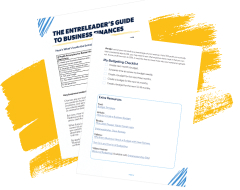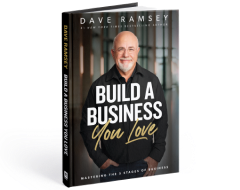Cash Flow vs. Profit: Which Is More Important?
8 Min Read | Apr 15, 2025

Maybe as a kid you knew you were born to be your own boss. So you started your first lemonade stand as soon as you got the hang of basic math. Or you might be an accidental entrepreneur living the dream (and sometimes nightmare) of a side hustle that exploded into a full-on business. Whatever your background and no matter what stage of business you’re in, one thing’s for sure—keeping up with the money side of business is freaking hard!
One of the biggest hurdles to running a successful business is good financial management. On one hand, you need to bring in money fast enough to cover daily orders and operations. But on the other hand, you’ve got to make sure you’re earning enough profit over time to stay in business. That’s a cash flow vs. profit challenge every business owner faces—and many don’t survive.
But that doesn’t have to be your story. Let’s dig in and find out how cash flow, profit and revenue work together so you can use that knowledge to keep your business going.
Cash Flow vs. Profit: Definitions
Let’s define a few important financial terms. Then we’ll unpack the big question of cash flow vs. profit— which is more important?
What Is Cash Flow?
Cash flow in business is the movement (or flow) of money into and out of your business measured over a specific time period—like a month or year. The idea of money that’s moving is important because cash flow doesn’t include money that's sitting in the bank, owed to you by customers, or credited by suppliers.
Think back to that grade school lemonade stand. Your cash flow would include all the money you made (cash inflow) from drink sales and paid (cash outflow) for ingredients, cups and the wages of any workers you wrangled to help.
For your current business, think of cash inflow as money coming in through:
- Product sales
- Services provided
- Property rent
- Interest and dividends
- Investor capital
- Grants or subsidies
- Royalties
And think of cash outflow as payment for things like:
- Supplies and inventory
- Operating expenses (rent, utilities, payroll)
- Taxes
- Capital expenditures (buying equipment and property)
- Fees for services
- Dividends to shareholders
- Interest on loans and payments to creditors
Here's A Tip
The best business is a debt-free business. Learn how you can run your business debt-free.
Positive cash flow means more money is moving into your business than out. To grow your business, you want consistent, positive cash flow.
Negative cash flow, on the other hand, means more money is flowing out of your company than into it. That’s okay if it’s temporary or planned (like during seasonal slumps) but negative cash flow over time is a recipe for financial disaster.
As you manage your cash flow, never buy the lie that you can outearn bad financial management. You can’t. Even if you’re a whiz at making sales and generating income, sooner or later the chaos of robbing Peter to pay Paul will catch up with you.
So, how do you see the true picture of your financial performance? By reviewing your profit and loss (P&L) statement every month. We’ll talk more about profit and loss in a minute, but since it’s directly tied to revenue, let’s look at that first.
Related article: 6 Small-Business Money Mistakes (and How to Avoid Them)
What Is Revenue in Business?
Revenue is your total business income earned through primary operations that include selling goods or providing services during a specific period. It’s what your business makes before subtracting production costs, taxes and overhead expenses.
For example, say last month you sold 1,000 cups of your fanciest gourmet lemonade served in a neighborhood souvenir cup for $7 each. That would give you $7,000 in revenue (1,000 x 7 = 7,000).
Tracking your revenue allows you to forecast and plan for business growth. It also helps you gauge your ability to cover costs and make a profit.
Don't Let Your Numbers Intimidate You
With the EntreLeader’s Guide to Business Finances, you can grow your profits without debt—even if numbers aren’t your thing.
What Is Profit in Business?
And what exactly do we mean by profit? In this instance, we’re talking about net profit—the most common of three types you need to know about.
Net profit is your net income after you’ve subtracted all your expenses from your revenue, including taxes and interest payments. Often, business owners refer to this number when they talk generally about their profit or net income. If you earn more than you spend, you’ve got a profit. But if you spend more than you make from your business operations, you’ve got a loss.
Going back to our example, if your lemonade sales revenue for last month was $7,000 and you paid out $4,000 in expenses for ingredients, cups, marketing, signage, taxes and payroll, that would give you $3,000 of net profit (7,000 – 4,000 = 3,000).
Gross profit refers to revenue minus the cost of goods sold (materials and labor) to produce your product. But it doesn’t include fixed costs you have to pay regardless of what you sell—like rent and payroll. Gross profit is good for assessing how efficient your production or sales process is, but net profit gives you a better picture of your overall profitability.
Operating profit is sometimes referred to as earnings before interest and tax (EBIT). To calculate operating profit, subtract your operating expenses from your gross profit—but not tax payments, interest on debt, or money coming in from areas beyond your core business. Companies often use operating profit to see how efficiently they’re managing their core operations.
Once you start earning (net) profit, what do you do with it? If you have business debt, we recommend these two actions together:
- Save 15–20% for retained earnings (aka emergency savings).
- Use 80–85% to aggressively pay off debt.
Once your debt is all paid off, celebrate your hard-earned financial peace big-time—and avoid future debt like the plague! Continue putting about 50% of your monthly profit into retained earnings until you reach 3–6 months of expenses.
Profit vs. Revenue
To keep revenue and profit straight, remember that revenue is your total business income generated and will always be the greater number.
Profit comes out of revenue. It’s what’s left after subtracting all your costs and expenses from your revenue. Looking at your profit gives you a more accurate measure of your financial health because it reflects how efficiently you’re operating, following a budget, and managing the money your company generates.
Your Road Map to Grow Your Business
Dave Ramsey’s new book Build a Business You Love is now available for purchase! This book will walk you through the same proven system Dave Ramsey used to build Ramsey Solutions from a card table in his living room to a $250 million company.
Cash Flow vs. Profit: What’s the Difference?
Do you feel like a cash flow vs. profit pro now? Just remember that the key difference between them boils down to these two things:
- Cash flow is simply the money moving into and out of your business throughout a given period.
- Profit is what’s left from your revenue once all your bills are paid.
The metric of time also sets the two apart. By that, we mean that cash flow is super important to meeting daily operations. And profit is super important to income generation and efficient cost management over the long term so you enjoy lasting growth.
Cash Flow, Profit or Revenue: What’s More Important?
Congratulations! With a whole lot more financial knowledge under your belt, you’ve come to the million-dollar question: Which is most important—cash flow or profit? Or could it be that revenue is the real MVP of good money management?
The truth is, all three are critical to helping you make healthy business decisions.
- You need revenue to be in business. Period. You can’t run a business if no money is coming in.
- You need profit to grow. Profit gives you margin to save for emergencies and opportunities to invest in more people, bigger space, newer technology and fresh ideas.
- You need healthy cash flow to stay afloat. Cash-flow problems lead to insufficient funds for expenses. And it’s impossible to operate long term if you've always got more month than money.
But as important as healthy revenue, profit and cash flow are to managing healthy business finances, there’s something even more important to your business—true, lasting financial peace. Wondering if you can experience something that sounds that good? Abso-freaking-lutely!
What Is Financial Peace in Business?
Financial peace in business doesn’t look like executives in suits sitting cross-legged in a board room while doing deep breathing exercises together. It’s also not about relaxing on your back deck in a Hawaiian shirt with an umbrella drink in hand (although that could be a perk if you play your cards right).
We’re talking about applying a set of business practices and principles that lead to these rewards:
- A debt-free business
- Consistent revenue
- Healthy cash flow and profit margins
- Retained earnings for emergencies, opportunities and even weird shifts in the economy
- Market-rate (or higher) pay for you and your team
- Restful, worry-free sleep when your head hits your pillow
These rewards ultimately give you peace of mind with your business finances. Money expert Dave Ramsey followed the practices and principles outlined in the EntreLeader’s Guide to Business Finances as he built his business debt-free. Now, thousands of businesses of all sizes follow the same principles to build debt-free businesses too. Learn how you can make your business story one of clearing money-management hurdles and enjoying both profit and peace.
What’s Next: Grow Your Profits and Your Peace
At EntreLeadership, we want you to have more than just healthy profit margins, strong cash flow and consistent revenue growth. We want you to have financial peace in your business. And it starts here.
Download the EntreLeader's Guide to Business Finances so that you can grow your profits without debt—even if numbers aren’t your thing.


